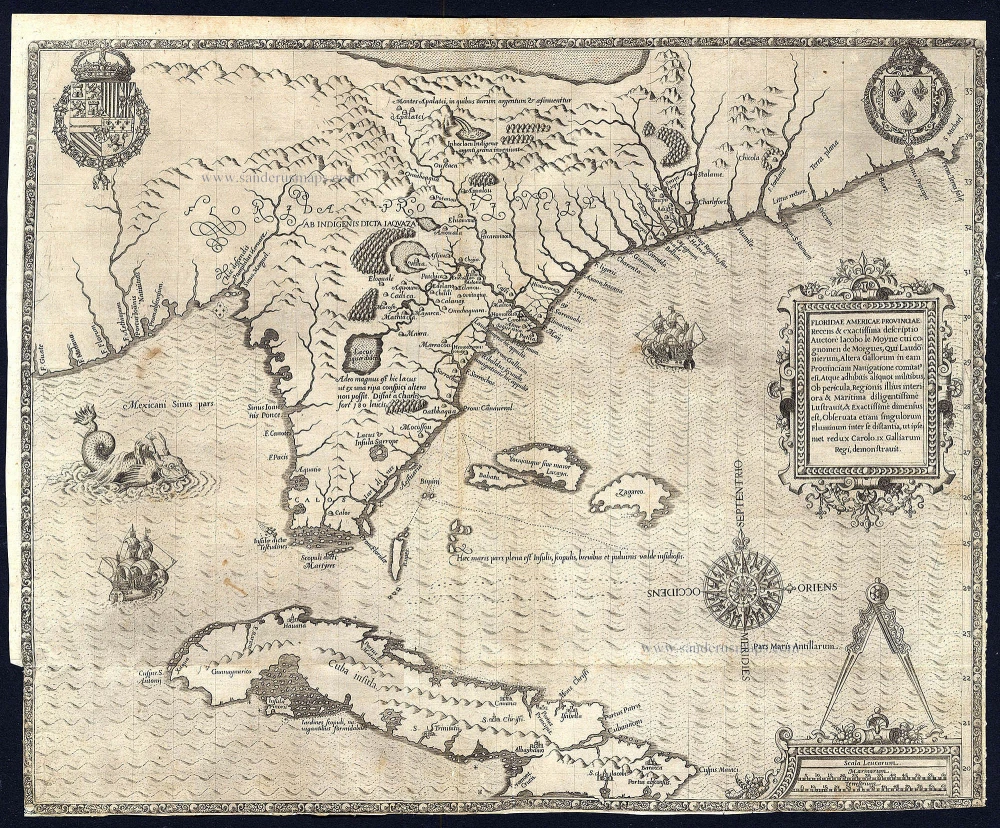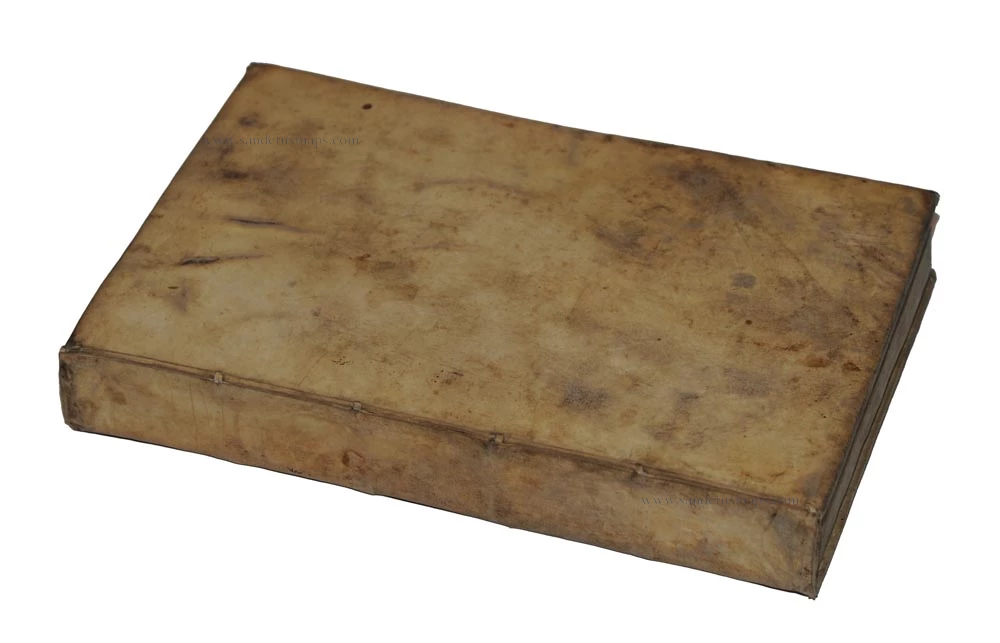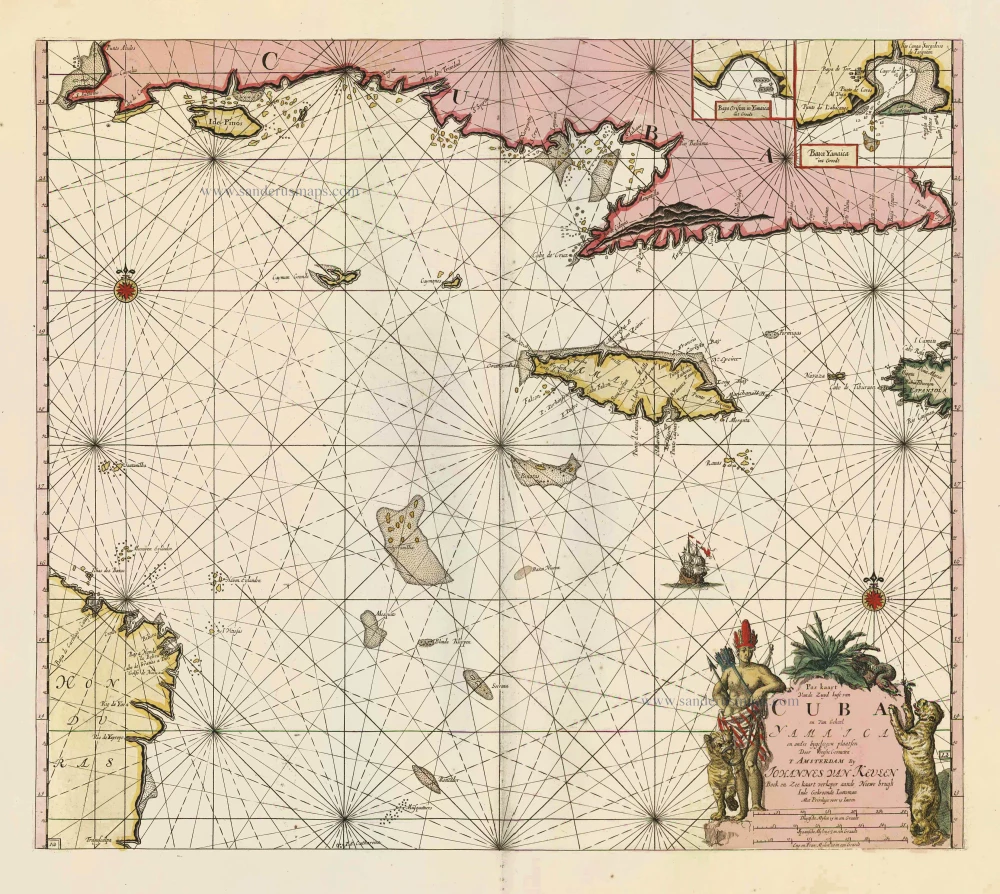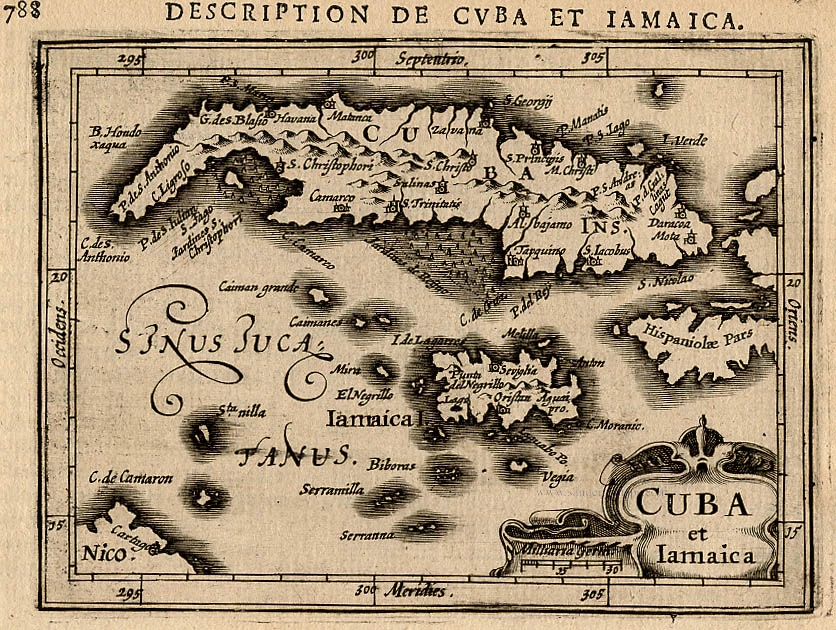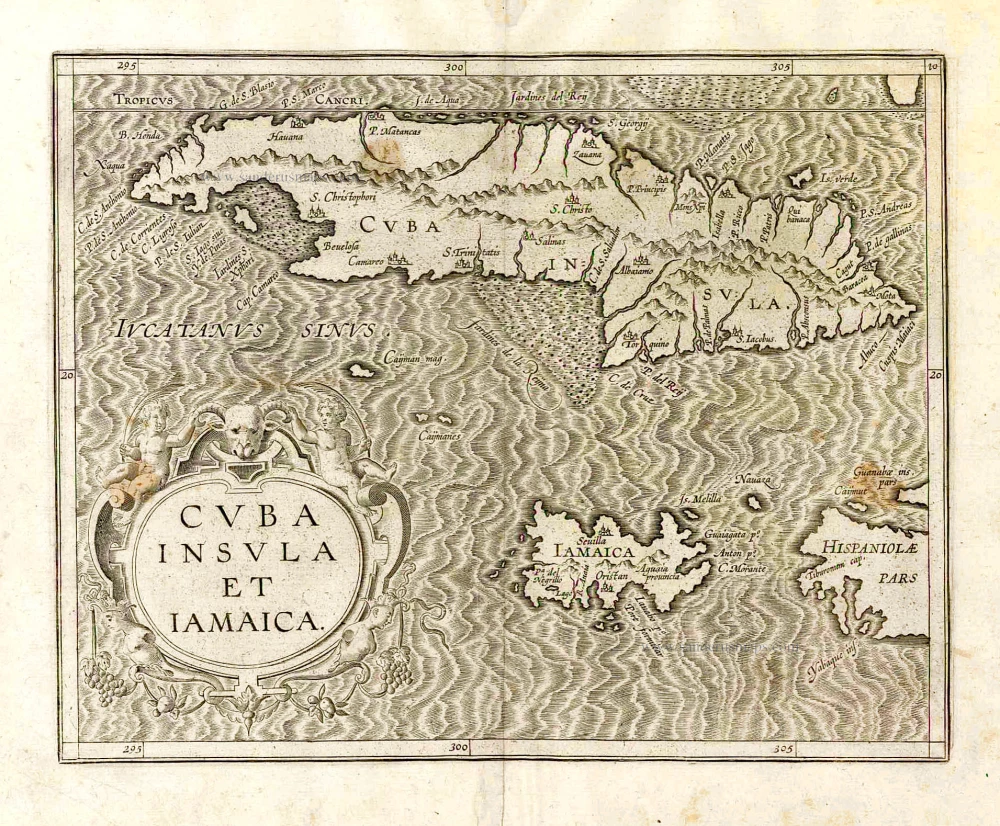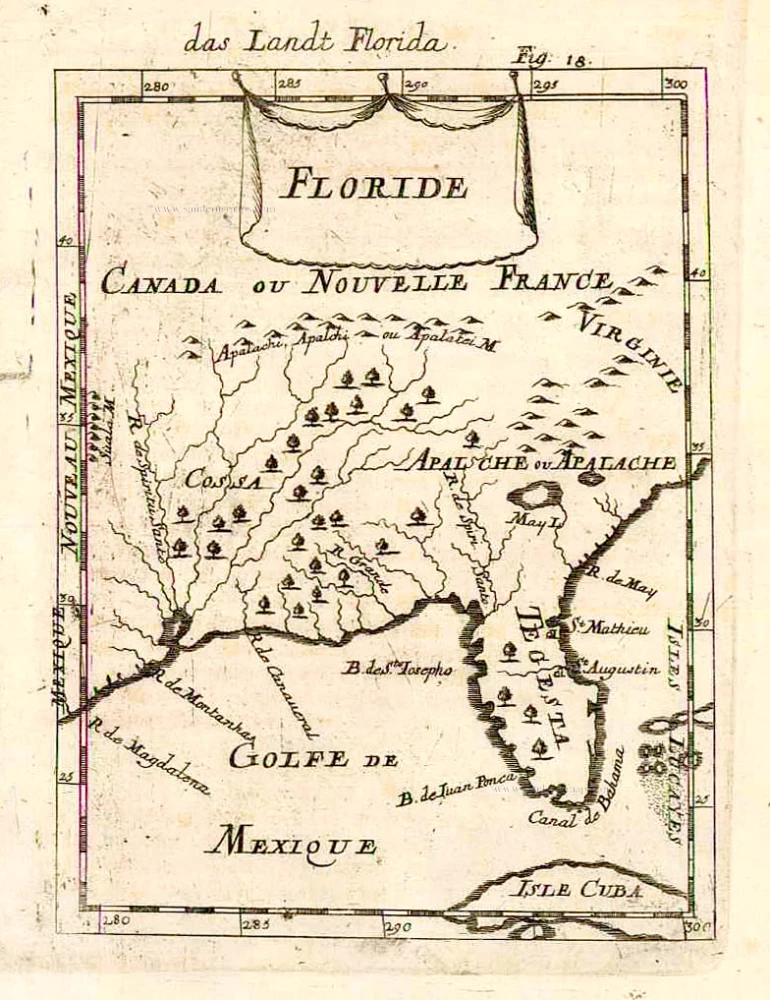Old, antique map of Florida & Cuba by de Bry - Le Moyne 1591
Theodore de Bry (1528 – 1598) and his family.
Theodore de Bry was born in 1528 in the Prince-Bishopric of Liège in the southern Netherlands (today Belgium). Trained as a goldsmith in his father's workshop, he left his home town around 1558 and moved to Strasbourg. Religious motives partly inspired his emigration, but commercial incentives were probably more critical for de Bry since Strasbourg was more attractive. Here, he gradually began to shift his focus to copper engraving. In the early 1560s, Theodore married Strasbourg-born Katharina Esslinger, and the couple went on to have four children together before Katharina died c. 1569. Johan Theodore (b. 1563) and Johan Israel (b. 1565) followed in their father's footsteps and took up his trade. He remarried in 1570 to Katharina Rölinger.
In 1577, after the Pacification of Gent had quietened religious tensions in the Netherlands, Theodore and his family moved to Antwerp. There, they lived close to the printing house of Christopher Plantin, and it was there that Theodore began making copper engravings. Copper engraving was a well-developed art in the Low Countries, and Antwerp artists were in great demand. In 1584, when Catholic troops besieged Antwerp, Theodore and his family moved to London, where he made copper engravings for an essential English navigation manual, The Mariners Mirrour. He also found the inspiration to produce the collection to which his name would forever be attached.
He met the artist Jacques Le Moyne de Morgues, a draughtsman who had been to Florida in the 1560s as part of a French expedition. He returned to Europe with watercolours of the natural world he had seen and the indigenous peoples. After Le Moyne's death, thanks to the mediation of Richard Hakluyt, Theodore acquired these drawings.
Hakluyt and de Bry began collaborating on a series of books about America. In 1588, the de Bry family moved to Frankfurt, where Theodore published the first volume of the America series. This first volume was the only one in the collection that appeared in four different languages: German, Latin, French and English. The following volumes appeared only in German and Latin. As a result, the relationship between de Bry and his English partners quickly soured.
Theodore continued publishing and produced a blend of richly illustrated prestigious volumes of the Voyages collection, the family firm's flagship publication.
Theodore de Bry died on March 27th, 1598. At this time, the highly successful and lucrative America series had already extended to seven volumes, and there would be fourteen. To these must be added the 'Elenchus', published in 1634 by Merian, which was a collective title and table of contents of these same volumes.
In 1597, the de Bry brothers published the first volume of the East India series. These were also published in folio but with slightly smaller page sizes than the America volumes. To distinguish the East India series from his America series, the two parallel sets subsequently became known among bibliophiles as de Bry’s Petits Voyages and his Grands Voyages, respectively.
The Petits Voyages consist of thirteen volumes, published between 1597 and 1633.
After Theodore de Bry's death, the business was run by his son, Johann Theodore and then by his grandson, Matthäus Merian and grandson-in-law, William Fitzer. Precisely what part de Bry's widow and his other son played in the business is unclear, but they certainly seemed to have retained some interest. After all, it must have become a very profitable venture for the whole family. Together, they continued to publish volumes of the Grands and Petits Voyages for another 46 years. The last volume, a third edition of Part IV of the America series, finally appeared in 1644.
Floridae Americae Provinciae Recens & Exactissima Descriptio Auctore Iacobo Le Moyne cui Cognomen de Morgues, qui Laudonierum ...
Item Number: 19287 Authenticity Guarantee
Category: Antique maps > America > West Indies
Old, antique map of Florida & Cuba, by Theodore de Bry - Jacques Le Moyne.
Copper engraving
Size: 37 x 46cm (14.4 x 17.9 inches)
Verso: Blank
Condition: Backed with paper at an early time, right and bottom margins + small part of left margin trimmed to neatline as issued, good copy.
References: Burden #79, Cumming, #14.
From: Le Moyne de Morgues Jacques. Brevis Narratio eorum quae in Florida Americae Provincia Gallis acciderant. Frankfurt, 1591.
Le Moyne's work is Part 2 of Theodorus De Bry's Collectiones Peregrinationum in Indiam Occidentalem. (25 parts) Frankfurt, 1590-1634. (= Grands Voyages)
"The author of this important map, Jacques Le Moyne, was an artist who accompanied Laudonnière on his ill-fated trip to Florida in 1564. He made graphic drawings of native scenes, a map of the region, and an accompanying narrative. De Bry saw Le Moyne in London in 1587 and attempted to obtain the drawings and papers. But Le Moyne, who was at the time in Ralegh's service, refused to part with them; soon after his death in 1588, however, De Bry purchased them from Le Moyne's widow and published them in 1591. The manuscript map is not extant, but it was in all probability used by John White in making the southern part of his La Virgenia Pars.
The map contains many striking details, frequently erronneous, which were incorporated in other maps for over 150 years. It was Le Moyne's misfortune to have many of his errors incorporated and even exaggerated in Mercator's map of 1606, upon which for half a century much of the subsequent cartography of the region was based.
Le Moyne's coastline is usually correct for latitude, but the shore extends too far east rather than northeast in direction. This caused a striking error in Mercator's map, with a compensating enlargement of the Virginia region; the mistake was corrected somewhat by Jansson 1641 and those who followed him.
Along the top of the map, to the north, extends the shore of a sea, probably Verrazano's Sea. It is unnamed and has no channel connecting it to the Atlantic. A similar body of water is found in Lescarbot 1611 and Seller 1649.
Along the coast are Latin names for rivers and bays, such as Gironda, Garumna, and Charenta, together with a few of the earlier Spanish names. The identification of the rivers has been attempted several times but it is doubtful whether Le Moyne had definite knowledge of the number of rivers along the coast himself. The names were given on the first voyage under Ribaut, who in his account makes some reference to their latitude and appearance. Most of the problems of toponymic identification have been solved by a recent analysis of a Spanish spy's tracing on transparent paper of a map made by Captain Nicolas Barré, Ribaut's able pilot on the 1562 voyage. Ribaut's names were eventually superseded by others when the seventeenth-century English settlers arrived; probably the only permanent coastal name first found on Le Moyne's map is "Portus Regalis" or Port Royal. ... " (Cumming)
Theodore de Bry (1528 – 1598) and his family.
Theodore de Bry was born in 1528 in the Prince-Bishopric of Liège in the southern Netherlands (today Belgium). Trained as a goldsmith in his father's workshop, he left his home town around 1558 and moved to Strasbourg. Religious motives partly inspired his emigration, but commercial incentives were probably more critical for de Bry since Strasbourg was more attractive. Here, he gradually began to shift his focus to copper engraving. In the early 1560s, Theodore married Strasbourg-born Katharina Esslinger, and the couple went on to have four children together before Katharina died c. 1569. Johan Theodore (b. 1563) and Johan Israel (b. 1565) followed in their father's footsteps and took up his trade. He remarried in 1570 to Katharina Rölinger.
In 1577, after the Pacification of Gent had quietened religious tensions in the Netherlands, Theodore and his family moved to Antwerp. There, they lived close to the printing house of Christopher Plantin, and it was there that Theodore began making copper engravings. Copper engraving was a well-developed art in the Low Countries, and Antwerp artists were in great demand. In 1584, when Catholic troops besieged Antwerp, Theodore and his family moved to London, where he made copper engravings for an essential English navigation manual, The Mariners Mirrour. He also found the inspiration to produce the collection to which his name would forever be attached.
He met the artist Jacques Le Moyne de Morgues, a draughtsman who had been to Florida in the 1560s as part of a French expedition. He returned to Europe with watercolours of the natural world he had seen and the indigenous peoples. After Le Moyne's death, thanks to the mediation of Richard Hakluyt, Theodore acquired these drawings.
Hakluyt and de Bry began collaborating on a series of books about America. In 1588, the de Bry family moved to Frankfurt, where Theodore published the first volume of the America series. This first volume was the only one in the collection that appeared in four different languages: German, Latin, French and English. The following volumes appeared only in German and Latin. As a result, the relationship between de Bry and his English partners quickly soured.
Theodore continued publishing and produced a blend of richly illustrated prestigious volumes of the Voyages collection, the family firm's flagship publication.
Theodore de Bry died on March 27th, 1598. At this time, the highly successful and lucrative America series had already extended to seven volumes, and there would be fourteen. To these must be added the 'Elenchus', published in 1634 by Merian, which was a collective title and table of contents of these same volumes.
In 1597, the de Bry brothers published the first volume of the East India series. These were also published in folio but with slightly smaller page sizes than the America volumes. To distinguish the East India series from his America series, the two parallel sets subsequently became known among bibliophiles as de Bry’s Petits Voyages and his Grands Voyages, respectively.
The Petits Voyages consist of thirteen volumes, published between 1597 and 1633.
After Theodore de Bry's death, the business was run by his son, Johann Theodore and then by his grandson, Matthäus Merian and grandson-in-law, William Fitzer. Precisely what part de Bry's widow and his other son played in the business is unclear, but they certainly seemed to have retained some interest. After all, it must have become a very profitable venture for the whole family. Together, they continued to publish volumes of the Grands and Petits Voyages for another 46 years. The last volume, a third edition of Part IV of the America series, finally appeared in 1644.

